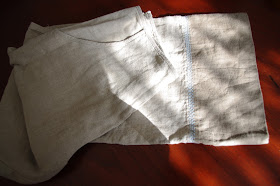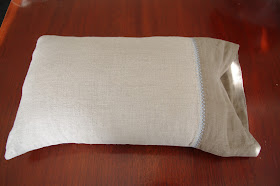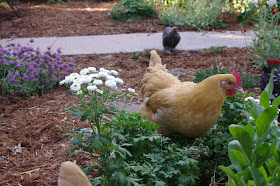 |
| Wilson in his hutch. |
Yes, that's a rabbit. Kind of resembles Tom Hank's famous volleyball co-star.
We settled his coop in the back of the chicken run, where he'll be sheltered (and locked up at night) and will be able to watch the chickens for entertainment. So now the chicken run is also a rabbit run.
 |
| English angoras are prized for their warm, soft fiber. |
I've not tried spinning angora yet, but it's said to be eight times warmer than sheep wool. I've heard that some spinners can sit at their wheel with the rabbit on their lap, plucking and spinning efficiently. Looking at Wilson, it's hard for me not to think, "Mmm. Yarn."
What the chickens think when they look at Wilson, I'm not sure. Wilson is big. Bigger than a cat, but similar. And they know the cats are easily chased. Violet stared him down like a predator, but he is oblivious. (Omnivorous, the chickens will chase mice. Last summer, Gertie caught and ate one in short order, much to L's shock.)
M and L were outside most of the day yesterday, visiting with the chickens and with Wilson. I looked out the window, and all of the hens, even the teenage Australorps, Betty and Poppy, were outside roaming the yard and exploring the garden. The snow had finally melted, and it was a happy hen scene.
A little while later, M came running in to tell me that Mabel fluffed up her hackles and spread out her (still growing) tail in warning to the large fluff ball that suddenly showed up in her world. Wilson paid her no mind.
I went out to see this bird-bunny interaction myself. M was holding Wilson after brushing him.
Mabel was happily pecking and scratching, with Poppy and Betty standing there behind her like slightly nervous sidekicks. M put Wilson on the ground about 10 feet in front of the hens. He reminded me of the Stay Puft Marshmallow monster in Ghostbusters. Benign, big, and unreal.
I don't think he could see the chickens in front of him with the mop on his head, and he hopped fast, straight toward them. The Australorps scattered as fast as their little scaly feet would carry them, wings spread. Mabel stared, unbelieving, and considered holding her ground for a split second. Then she clucked a combination of indignant and panicked bock bock bocks, threw up her wings, turned, and ran for her life. It was a little undignified.
Wilson was unaware that he'd caused a flurry. He continued hopping happily around the yard. Mabel eyed him from a distance, then turned and chased a pigeon as if to soothe her wounded pride.

































